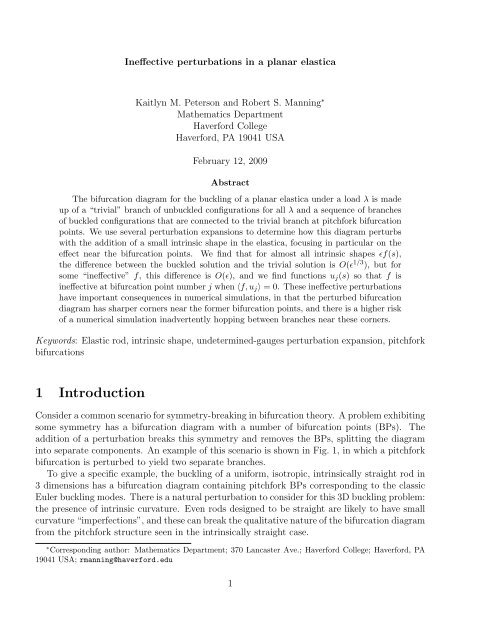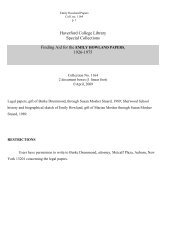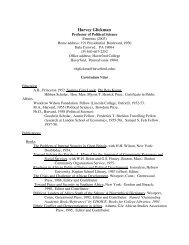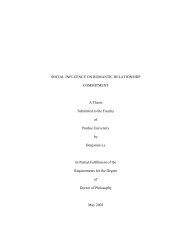1 Introduction - Haverford College
1 Introduction - Haverford College
1 Introduction - Haverford College
Create successful ePaper yourself
Turn your PDF publications into a flip-book with our unique Google optimized e-Paper software.
Ineffective perturbations in a planar elastica<br />
Kaitlyn M. Peterson and Robert S. Manning ∗<br />
Mathematics Department<br />
<strong>Haverford</strong> <strong>College</strong><br />
<strong>Haverford</strong>, PA 19041 USA<br />
February 12, 2009<br />
Abstract<br />
The bifurcation diagram for the buckling of a planar elastica under a load λ is made<br />
up of a “trivial” branch of unbuckled configurations for all λ and a sequence of branches<br />
of buckled configurations that are connected to the trivial branch at pitchfork bifurcation<br />
points. We use several perturbation expansions to determine how this diagram perturbs<br />
with the addition of a small intrinsic shape in the elastica, focusing in particular on the<br />
effect near the bifurcation points. We find that for almost all intrinsic shapes ɛf(s),<br />
the difference between the buckled solution and the trivial solution is O(ɛ 1/3 ), but for<br />
some “ineffective” f, this difference is O(ɛ), and we find functions u j (s) so that f is<br />
ineffective at bifurcation point number j when 〈f, u j 〉 = 0. These ineffective perturbations<br />
have important consequences in numerical simulations, in that the perturbed bifurcation<br />
diagram has sharper corners near the former bifurcation points, and there is a higher risk<br />
of a numerical simulation inadvertently hopping between branches near these corners.<br />
Keywords: Elastic rod, intrinsic shape, undetermined-gauges perturbation expansion, pitchfork<br />
bifurcations<br />
1 <strong>Introduction</strong><br />
Consider a common scenario for symmetry-breaking in bifurcation theory. A problem exhibiting<br />
some symmetry has a bifurcation diagram with a number of bifurcation points (BPs). The<br />
addition of a perturbation breaks this symmetry and removes the BPs, splitting the diagram<br />
into separate components. An example of this scenario is shown in Fig. 1, in which a pitchfork<br />
bifurcation is perturbed to yield two separate branches.<br />
To give a specific example, the buckling of a uniform, isotropic, intrinsically straight rod in<br />
3 dimensions has a bifurcation diagram containing pitchfork BPs corresponding to the classic<br />
Euler buckling modes. There is a natural perturbation to consider for this 3D buckling problem:<br />
the presence of intrinsic curvature. Even rods designed to be straight are likely to have small<br />
curvature “imperfections”, and these can break the qualitative nature of the bifurcation diagram<br />
from the pitchfork structure seen in the intrinsically straight case.<br />
∗ Corresponding author: Mathematics Department; 370 Lancaster Ave.; <strong>Haverford</strong> <strong>College</strong>; <strong>Haverford</strong>, PA<br />
19041 USA; rmanning@haverford.edu<br />
1
Figure 1: Standard perturbation of a pitchfork bifurcation into two separate branches<br />
Such elastic rod models have been used to represent the bending and twisting of DNA. For<br />
many DNA sequences, the intrinsic shape is nearly straight, but the minimum-energy stacking<br />
configurations of consecutive base-pairs does introduce small intrinsic bends that depend on<br />
the specific sequence of the DNA. Multiple studies have sought to determine these stacking<br />
configurations as a function of sequence (e.g., [15, 1, 14, 3]), and then derive from these stacking<br />
configurations the corresponding intrinsic curvature for a continuum elastic rod (e.g., [10]).<br />
These DNA models have seen increasing use in studying a phenomenon called “DNA looping”:<br />
the bending and twisting of DNA a few hundreds of basepairs long in response to prescribed<br />
relative positions and orientations of the two ends (these boundary conditions coming<br />
from, for example, a bound protein of known structure [18, 7, 9] or laser tweezer experiments<br />
[16, 11]). Given the wide variety of DNA sequences, and the almost-as-wide variety of parameters<br />
for determining local bending from sequence, it would be beneficial to have an automated<br />
algorithm to compute the lowest-energy components of the bifurcation diagram given specified<br />
choices of DNA sequence, stacking parameters, and boundary conditions. A strong understanding<br />
of the splitting of the unperturbed pitchfork diagram for base cases such as buckling<br />
or periodic boundary conditions is an important precursor to ensuring that such an automated<br />
algorithm finds all relevant components of the diagram.<br />
How typical is the “standard” splitting shown in Fig. 1? We analyzed this question for one<br />
of the simplest bifurcation problems—the buckling of a planar elastica—under the family of<br />
perturbations of (infinitesimal) intrinsic curvature. Like the 3D buckling problem described<br />
above, this problem exhibits a sequence of pitchfork BPs. This 2D problem is useful as a<br />
base case for the more general 3D DNA looping problem. The formulation of 2D bending<br />
is simple enough that closed-form analysis is not too unwieldy; at the same time, it seems<br />
reasonable to suppose that the 3D results would be analogous, since, in some sense, 3D bending<br />
is composed of two orthogonal directions of 2D bending. The particular buckling boundary<br />
conditions we choose yield a classic problem in mechanical engineering, but are not the typical<br />
boundary conditions for DNA looping. Still, a likely computational approach to determining<br />
configurations obeying arbitrary DNA looping boundary conditions would involve beginning<br />
2
from one of a small number of simple configurations, one of which would be the straight-rod<br />
configuration studied here (in addition, to, perhaps, a circle and a semicircle).<br />
Thus, this choice of a simple model problem should allow us to focus on the fundamental<br />
questions of which perturbations are atypical and how the bifurcation diagrams of atypical<br />
perturbations differ from the typical case. Our main finding is that for these atypical cases,<br />
the perturbation of the BP is significantly smaller than in the typical case, leading us to label<br />
these perturbations as “ineffective”.<br />
This question is related to the analysis of “unfolding” a pitchfork bifurcation diagram in<br />
dynamical systems, see, e.g., [5, 8]. The standard example is to consider the algebraic equation<br />
λx − x 3 = 0, which exhibits a pitchfork BP at λ = 0. The addition of a second parameter, e.g.,<br />
α+λx−x 3 = 0, splits the diagram as in Fig. 1 if α ≠ 0. The boundary case α = 0 is the analogue<br />
of the ineffectiveness condition we derive for the elastica, although the analysis and final result<br />
are more involved since our mathematical setting is an ODE (plus boundary conditions and<br />
an integral constraint) rather than an algebraic equation, and the perturbations considered are<br />
a space of functions rather than a single parameter. Furthermore, in the standard unfolding<br />
study, the focus is generally on α = 0 as the transition between qualitative behaviors, whereas<br />
we focus on determining the leading-order behaviors of solutions both away from, and directly<br />
on, this boundary case.<br />
In addition to this theoretical analysis, we present some computational results motivated<br />
by the idea of deriving an automated algorithm to determine DNA looping configurations.<br />
One approach to performing such computations is to use exactly the symmetry-breaking path<br />
considered here: begin with the symmetric problem for which solutions are known, and proceed<br />
via a continuation algorithm to numerical solutions for the perturbed problem. We explore<br />
how these continuation algorithms can fail if the perturbation is ineffective (or even nearly<br />
ineffective), due to the presence of sharp corners in a branch of solutions. Thus, in designing<br />
a system for automatically computing such bifurcation diagrams for a wide range of intrinsic<br />
shapes, the ineffectivity conditions we derive serve as an important red flag that numerical<br />
difficulties may arise in a specific subset of computations.<br />
Our analysis proceeds as follows. First, we formulate the planar buckling problem in Sec. 2,<br />
including an O(ɛ) intrinsic-curvature term. Next, in Sec. 3, we apply a standard perturbation<br />
expansion to the “trivial branch” of ɛ = 0 unbuckled configurations. Away from the BPs, this<br />
expansion gives an O(ɛ) approximation to the perturbation of the trivial branch. At the BPs,<br />
this analysis breaks down for most intrinsic curvature profiles, but for certain special profiles,<br />
it does still yield an O(ɛ) solution. These cases are exactly the ineffective perturbations, and<br />
we derive conditions for when they occur. In Sec. 4, we apply an alternative perturbation<br />
technique called undetermined gauges to the effective perturbations at the BPs and find an<br />
O(ɛ 1/3 ) leading-order term for the perturbation of the unbuckled configuration. Finally, in Sec.<br />
5, we present several examples illustrating the theory and a computational study verifying the<br />
numerical difficulties created by ineffective or nearly ineffective perturbations.<br />
3
2 The planar buckling problem<br />
We consider an inextensible and unshearable elastic rod in the plane, assumed for simplicity to<br />
have total arclength 1. We parametrize the rod by arclength s, and denote the configuration of<br />
the rod at arclength-value s by (x(s), y(s)). We choose coordinates and boundary conditions as<br />
shown in Fig. 2: the s = 0 end of the rod is at the origin, we impose clamped boundary conditions<br />
at each end requiring the tangent vectors to be vertical, and further require x(1) = 0. The<br />
inextensibility-unshearability constraint implies that (x ′ (s), y ′ (s)) is a unit vector; this allows us<br />
to describe the rod by a single unknown function θ(s), where (x ′ (s), y ′ (s)) = (cos θ(s), sin θ(s)).<br />
The clamped boundary conditions are given by θ(0) = θ(1) = 0, and the additional constraint<br />
x(1) = 0 can be rewritten as ∫ 1<br />
sin θ(s)ds = 0.<br />
0<br />
Figure 2: Boundary conditions on the planar elastica. The s = 0 end of the rod is held at the<br />
origin with vertical tangent, while the s = 1 end of the rod is held at x = 0, also with vertical<br />
tangent.<br />
We place a mass m > 0 at the s = 1 end of the rod, and assume the following functional for<br />
the energy of the rod-plus-mass system:<br />
∫ 1<br />
[ K<br />
E[θ] ≡<br />
2 (θ′ (s) − ɛf(s)) 2 + mg cos θ(s)]<br />
ds.<br />
0<br />
The first term represents the bending energy of the rod, and the second term the potential<br />
energy of the load. The term ɛf(s) is used to model intrinsic curvature: the minimum-energy<br />
configuration of the rod has θ ′ (s) = ɛf(s), and deviations from ɛf(s) involve a quadratic energy<br />
cost, weighted by the stiffness parameter K. For simplicity, we express energy in units of K,<br />
and define λ = mg/K > 0, so that the energy functional becomes:<br />
∫ 1<br />
[ 1<br />
E[θ] =<br />
2 (θ′ (s) − ɛf(s)) 2 + λ cos θ(s)]<br />
ds.<br />
0<br />
4
We thus consider the calculus of variations problem to find critical points of E subject to<br />
the boundary conditions θ(0) = θ(1) = 0 and the isoperimetric constraint ∫ 1<br />
sin θ(s)ds = 0.<br />
0<br />
These critical points are found by solving the ordinary differential equation (ODE) defined by<br />
the Euler-Lagrange equation (with Lagrange multiplier µ included because of the isoperimetric<br />
constraint):<br />
θ ′′ (s) = ɛf ′ (s) − λ sin θ(s) + µ cos θ(s).<br />
Thus, the mathematical problem we considered was, given known values for the load λ,<br />
perturbation parameter ɛ, and intrinsic curvature profile f(s) (with f ′ not identically zero,<br />
since otherwise ɛ has no effect), find solutions (θ(s), µ) of<br />
θ ′′ (s) = ɛf ′ (s) − λ sin θ(s) + µ cos θ(s)<br />
θ(0) = θ(1) = 0,<br />
∫ 1<br />
0<br />
sin θ(s)ds = 0.<br />
For ɛ = 0, the solutions to (1) as λ varies yield the familiar force-length diagram seen in<br />
Fig. 3 (all bifurcation diagrams in this article were computed using the parameter-continuation<br />
package AUTO97, http://indy.cs.concordia.ca/auto [4]). One solution (for each value of<br />
λ) is θ(s) ≡ 0, µ = 0 (a straight rod), and this corresponds to the horizontal line at the top of<br />
Fig. 3. We call this the “trivial branch”.<br />
(1)<br />
Figure 3: Bifurcation diagram for a planar elastica with no intrinsic curvature (ɛ = 0). The<br />
height of the top of the rod (y(1)) is plotted against the imposed load λ.<br />
There are pitchfork bifurcation points † at all values of λ satisfying<br />
2 − 2 cos √ λ − √ λ sin √ λ = 0 (2)<br />
† The appearance of the pitchfork bifurcation points in Figure 3 is slightly different than the standard picture<br />
from Figure 1 since the two outer prongs of the pitchfork are folded on top of each other due to the choice of<br />
y(1) as ordinate.<br />
5
(see Sec. 3 for a derivation of this equation). This equation has a countable sequence of solutions<br />
that we will label as 0 < λ 1 < λ 2 < · · · . For n odd, λ n = (n + 1) 2 π 2 , whereas for n even,<br />
(n + 0.5) 2 π 2 < λ n < (n + 1) 2 π 2 with (n + 1) 2 π 2 − λ n → 0 as n → ∞. Two properties of λ n (for<br />
n even) will be useful to us:<br />
Lemma 1. For n even,<br />
sin √ λ n = 4√ λ n<br />
λ n + 4 , cos √ λ n = 4 − λ n<br />
λ n + 4 .<br />
Proof: By (2), we have<br />
1 − cos √ λ n =<br />
Multiplying these two equations, we find:<br />
Collecting terms,<br />
√<br />
λn sin √ λ n<br />
, 1 + cos √ √<br />
λn sin √ λ n<br />
λ n = 2 −<br />
.<br />
2<br />
2<br />
sin √ 2 λ n = √ λ n sin √ λ n − λ n sin √ 2 λ n<br />
.<br />
4<br />
sin √ (<br />
2 λ n 1 + λ )<br />
n<br />
= √ λ n sin √ λ n ,<br />
4<br />
and since sin √ λ n ≠ 0 for n even, we may divide both sides by it and solve for sin √ λ n to find<br />
the desired result.<br />
The formula for cos √ λ n follows from the formula cos √ λ n = − √ 1 − sin √ 2 λ n (note the<br />
minus sign due to the fact that √ λ n is just below an odd multiple of π). □<br />
Lemma 2. For n even, −λ n − λ n cos √ λ n + 2 √ λ n sin √ λ n = 0.<br />
Proof: Since (n + 0.5) 2 π 2 < λ n < (n + 1) 2 π 2 , we have sin √ λ n ≠ 0 and 1 − cos( √ λ n ) ≠ 0.<br />
Thus<br />
sin √ λ n<br />
1 − cos √ λ n<br />
= 1 + cos √ λ n<br />
sin √ λ n<br />
, (3)<br />
since cross-multiplying yields the identity 1 − cos 2 √ λ n = sin 2 √ λ n . By (2), the left-hand side<br />
of (3) equals 2/ √ λ n , and therefore,<br />
1 + cos √ λ n<br />
sin √ λ n<br />
= 2 √<br />
λn<br />
.<br />
Cross-multiplying, and multiplying both sides by √ λ n , yields the desired equality. □<br />
6
3 Perturbation of trivial branch for small ɛ<br />
For fixed λ > 0, f(s), and ɛ > 0, we now seek a solution to (1) that will be close to the solution<br />
on the trivial branch for ɛ = 0. We use a standard perturbation analysis, writing<br />
θ(s) = θ 0 (s) + ɛθ 1 (s) + · · ·<br />
µ = µ 0 + ɛµ 1 + · · ·<br />
The O(1) terms θ 0 (s) and µ 0 vanish since µ = 0 and θ(s) ≡ 0 on the trivial branch. Therefore,<br />
we seek the O(ɛ) terms θ 1 (s) and µ 1 , by plugging these expansions into (1). After Taylor<br />
expanding sin θ and cos θ and isolating the O(ɛ) terms we find:<br />
θ ′′<br />
1 = f ′ (s) − λθ 1 + µ 1 , θ 1 (0) = θ 1 (1) = 0,<br />
∫ 1<br />
0<br />
θ 1 (s)ds = 0. (4)<br />
By a standard integrating factor approach, we find the general solution to the ODE in (4):<br />
θ 1 (s) = √ 1 ∫ s<br />
λ<br />
0<br />
f ′ (t) sin( √ λ(s − t))dt + µ 1<br />
λ + C 1 cos( √ λs) + C 2 sin( √ λs)<br />
When we require that this general solution satisfy the remaining conditions in (4), we find three<br />
linear equations in µ 1 , C 1 , and C 2 :<br />
⎡<br />
⎤ ⎡ ⎤ ⎡<br />
⎤<br />
1/λ 1 0<br />
⎣1/λ cos √ λ sin √ µ 1<br />
0<br />
λ<br />
1/λ (sin √ λ)/ √ λ (1 − cos √ λ)/ √ ⎦ ⎣C 1<br />
⎦ = ⎣ (1/ √ λ) ∫ 1<br />
f ′ (t) sin( √ λ(1 − t))dt<br />
0<br />
λ C 2 (1/ √ λ) ∫ 1 ∫ s<br />
f ′ (t) sin( √ ⎦<br />
λ(s − t))dtds<br />
0 0<br />
(5)<br />
The bottom term on the right-hand side can be simplified by switching the order of integration:<br />
∫ 1 ∫ 1<br />
and then computing the inner integral:<br />
1<br />
λ<br />
0<br />
∫ 1<br />
0<br />
t<br />
f ′ (t)<br />
(√ )<br />
√ sin λ(s − t)<br />
λ<br />
ds dt,<br />
[ (√ )]<br />
f ′ (t) 1 − cos λ(1 − t)<br />
Inserting this into (5), and multiplying both sides by λ, gives:<br />
⎡<br />
⎤ ⎡ ⎤ ⎡<br />
⎤<br />
1 λ 0<br />
⎣1 λ cos √ λ λ sin √ µ 1 √<br />
0<br />
∫<br />
λ<br />
1 √ λ sin √ λ √ λ(1 − cos √ ⎦ ⎣C 1<br />
⎦ = ⎣ 1<br />
λ f ′ (t) sin( √ λ(1 − t))dt<br />
∫ 0<br />
λ) C 1<br />
2 f ′ (t)[1 − cos( √ ⎦ (6)<br />
λ(1 − t))] dt<br />
0<br />
The matrix on the left-hand side has determinant λ 3/2 (2 cos √ λ − 2 + √ λ sin √ λ), so (6) has<br />
a unique solution if 2 cos √ λ − 2 + √ λ sin √ λ ≠ 0. In other words, referring back to (2), we<br />
dt.<br />
7
have shown that away from the bifurcation points, i.e., for λ ≠ λ n , the standard perturbation<br />
expansion yields a solution, i.e., a O(ɛ) approximation to θ(s) near the trivial branch.<br />
(We note that the BP condition (2) can be derived by a computation much like the one just<br />
completed; in that instance, we would be looking for solutions near the trivial branch to the<br />
problem without the f ′ term. We would use the same perturbation expansion, resulting in (6)<br />
but with a zero vector as the right-hand side, and so we would have a nontrivial solution (a<br />
BP) exactly when the determinant of the matrix vanishes.)<br />
What is particularly interesting for our study is whether (6) might have a solution even at<br />
a bifurcation point. Here we can use the following (see, e.g., [17, §3.4]):<br />
Theorem 1. For an n × n matrix A, the column space of A is equal to the orthogonal complement<br />
of the nullspace of A T .<br />
We want to know whether the right-hand side b of (6) is in the column space of the matrix<br />
A on the left-hand side, which by Theorem 1 is true if and only if 〈b, u〉 = 0 for all nullvectors<br />
u of A T . The nullvector for λ = λ n has a different form depending on whether n is odd or<br />
even.<br />
If n is odd, then λ n = (n + 1) 2 π 2 and<br />
⎡<br />
1 1<br />
⎤<br />
1<br />
A T = ⎣(n + 1) 2 π 2 (n + 1) 2 π 2 0⎦ ,<br />
0 0 0<br />
and nullspace (A T ) = span {(−1, 1, 0)}.<br />
If n is even, then there is no obvious simplification to be made to the form of the matrix:<br />
⎡<br />
⎤<br />
1 1 1<br />
A T = ⎣λ<br />
cos √ √ √<br />
λ λ sin λ<br />
0 λ sin √ λ √ λ(1 − cos √ ⎦ ,<br />
λ)<br />
but, using (2) and Lemma 2, it can be verified that nullspace (A T ) = span {(−1, −1, 2)}.<br />
Combining these nullvectors of A T with Theorem 1 shows that (6) has a solution at λ n if<br />
and only if<br />
∫ 1<br />
0<br />
∫ 1<br />
0<br />
f ′ (t) sin( √ λ n (1 − t))dt = 0, for n odd<br />
[ (√ )<br />
f ′ (t) 2 − 2 cos λn (1 − t) − √ (√ )]<br />
λ n sin λn (1 − t) dt = 0, for n even<br />
Intrinsic curvature profiles f satisfying (7) for some n are the “ineffective” perturbations for<br />
bifurcation point λ n .<br />
(7)<br />
4 Undetermined-gauges analysis of bifurcation points<br />
We now turn to the analysis of the bifurcation points λ = λ n . In Sec. 3 we showed that for the<br />
ineffective perturbations defined by (7), the standard perturbation analysis predicts an O(ɛ)<br />
8
lowest-order term for θ 1 and µ 1 , but that this analysis fails for the remaining perturbations. Here<br />
we investigate those cases by applying a more general technique, the methods of undetermined<br />
gauges [12], which is used to derive the leading-order behavior when it does not follow the<br />
standard O(ɛ) pattern.<br />
We are, as before, considering (1), but now we formulate a more general perturbation expansion<br />
for θ and µ. This expansion is computed one term at a time, so we begin by writing:<br />
θ(s) = δ 1 (ɛ)θ 1 (s), µ = δ 1 (ɛ)µ 1 ,<br />
where δ 1 (ɛ) is an unknown function of ɛ that our analysis will determine. We will restrict<br />
attention to the family δ 1 (ɛ) = ɛ a for a real. We insert these expressions into (1) and expand<br />
the sin and cos as Taylor series:<br />
δ 1 θ 1 ′′ = ɛf ′ (s) − λ n (δ 1 θ 1 + · · · ) + (δ 1 µ 1 )(1 + · · · ),<br />
δ 1 θ 1 (0) = δ 1 θ 1 (1) = 0,<br />
∫ 1<br />
0<br />
(δ 1 θ 1 + · · · )ds = 0.<br />
We want to look at the leading order terms, but in the ODE, there is a question of whether δ 1<br />
or ɛ is dominant, or if they could be of the same order. If ɛ were dominant, then the leadingorder<br />
terms of the ODE would be the nonsensical 0 = ɛf ′ (s). If δ 1 and ɛ were of the same<br />
order, i.e., δ 1 = ɛ, then the leading-order terms of the ODE would give the same equation as in<br />
the standard perturbation expansion, which we know from Sec. 3 has no solution. Hence, the<br />
dominant term must be δ 1 , so we keep the O(δ 1 ) terms to find:<br />
θ ′′<br />
1 = −λ n θ 1 + µ 1 , θ 1 (0) = θ 1 (1) = 0,<br />
∫ 1<br />
0<br />
θ 1 (s)ds = 0.<br />
The general solution of the ODE is θ 1 (s) = C 1 cos( √ λ n s) + C 2 sin( √ λ n s) + µ 1 /λ n . Imposing<br />
θ 1 (0) = 0, we find µ 1 = −λ n C 1 , and then the other two conditions give the linear system:<br />
[ √ cos λn − 1 sin √ ] [C1 ] [<br />
λ n 0<br />
sin √ √λn<br />
λ n 1−cos<br />
− 1<br />
√ √λn<br />
λ n<br />
= .<br />
C 2 0]<br />
Since the determinant of the matrix in this system is zero by (2), we have nontrivial solutions<br />
(C 1 , C 2 ), namely any nonzero nullvector of the matrix. If n is odd, the matrix simplifies to<br />
[ ] 0 0<br />
,<br />
−1 0<br />
so that (0, 1) is a nullvector and the solution coming from this first gauge is:<br />
θ 1 = C sin( √ λ n s) = C sin(π(n + 1)s)<br />
µ 1 = 0<br />
(n odd, C ≠ 0 to be determined) (8)<br />
9
On the other hand, if n is even, then (sin √ λ n , 1 − cos √ λ n ) is a nullvector of the matrix, which<br />
means that the solution coming from this first gauge is:<br />
θ 1 = k<br />
[sin √ ( (√ ) )<br />
λ n cos λn s − 1 + (1 − cos √ (√ )]<br />
λ n ) sin λn s<br />
µ 1 = −kλ n sin √ λ n<br />
By (2), 1 − cos √ λ n = 1 2√<br />
λn sin √ λ n , so that this solution can be rewritten as:<br />
θ 1 = k sin √ (√ )<br />
λ n<br />
(cos λn s − 1 + 1 (√ )<br />
λn sin λn s<br />
2√ )<br />
µ 1 = −kλ n sin √ λ n<br />
For simplicity, we write k sin √ λ n /2 as a single constant C for the final form of the solution:<br />
( (√ )<br />
θ 1 = C 2 cos λn s − 2 + √ (√ ))<br />
λ n sin λn s<br />
(n even, C ≠ 0 to be determined) (9)<br />
µ 1 = −2Cλ n<br />
In order to determine C and δ 1 , we add another gauge.<br />
θ = δ 1 (ɛ)θ 1 (s) + δ 2 (ɛ)θ 2 (s), µ = δ 1 (ɛ)µ 1 + δ 2 (ɛ)µ 2 ,<br />
for δ 2 (ɛ) an unknown function of ɛ (again in the family ɛ a ), by definition of lower order in ɛ than<br />
δ 1 . As before, we insert these expressions into (1) and Taylor-expand the sin and cos terms,<br />
looking for the next-lowest-order terms after O(δ 1 ).<br />
For the boundary conditions, these next-lowest-order terms give δ 2 (ɛ)θ 2 (0) = δ 2 (ɛ)θ 2 (1) = 0,<br />
or θ 2 (0) = θ 2 (1) = 0. As for the integral condition, since sin θ = θ − θ 3 /6 + · · · , there are two<br />
next-lowest-order candidates: δ 2 from the θ term, and δ 3 1 from the θ 3 term. We list them both<br />
for the time being:<br />
∫ 1<br />
0<br />
(δ 2 θ 2 (s) − 1 6 (δ 1) 3 θ 1 (s) 3 + · · · )ds = 0, (10)<br />
Finally, we look at the ODE. The sin term yields the same two possible second-lowest-order<br />
terms δ 2 or (δ 1 ) 3 as in the integral condition, and so, in fact, does the cos term (δ 2 from the<br />
δ 2 µ 2 term in µ times the 1 in the cos expansion, or (δ 1 ) 3 from the δ 1 µ 1 term in µ times the<br />
−(δ 1 θ 1 ) 2 /2 from the cos expansion):<br />
δ 2 θ 2 ′′ = ɛf ′ (s) − λ n<br />
[δ 2 θ 2 (s) − 1 ]<br />
6 (δ 1) 3 (θ 1 (s)) 3 + · · ·<br />
+<br />
[<br />
δ 2 µ 2 − 1 ]<br />
2 (δ 1) 3 µ 1 (θ 1 (s)) 2 + · · · . (11)<br />
Overall, there are three candidates for next-lowest-order term: ɛ, δ 2 , and (δ 1 ) 3 . We have to<br />
consider all possibilities for the relative rankings of these terms, including ties. The arguments<br />
below rule out all possibilities except having all three of the same order.<br />
Case 1: ɛ lowest-order<br />
10
This can not be true, since the dominant terms in (11) would give 0 = f ′ (s), but by assumption<br />
f ′ is not identically zero. □<br />
Case 2: (δ 1 ) 3 lowest-order<br />
This can not be true, since the dominant terms in (11) would give 0 = − 1 6 (θ 1(s)) 2 (θ 1 (s)+3µ 1 ),<br />
and neither θ 1 nor θ 1 + 3µ 1 is identically zero. □<br />
Case 3: δ 2 lowest-order<br />
The dominant terms in (11) would give the same equation we solved for θ 1 and µ 1 (including<br />
the boundary and integral conditions), so that θ 2 = θ 1 and µ 2 = µ 1 . Thus, our gauge expansions<br />
would reduce to θ = (δ 1 + δ 2 )θ 1 and µ = (δ 1 + δ 2 )µ 1 , and we would essentially be back where we<br />
began this step, having replaced the unknown δ 1 (ɛ) by another unknown δ 1 (ɛ) + δ 2 (ɛ), without<br />
having learned anything about the connection of δ 1 to ɛ. Thus, we reject this case. □<br />
Case 4: ɛ and (δ 1 ) 3 tied for lowest-order<br />
Since (δ 1 ) 3 = ɛ, the dominant terms in (11) would give 0 = f ′ (s) − 1 6 (θ 1(s)) 3 . This requires<br />
the perturbation f ′ to take the very particular form of the cubes of the functions (8) or (9).<br />
Since this case does not yield a solution for a general perturbation, we reject this case. □<br />
Case 5: ɛ and δ 2 tied for lowest-order<br />
This can not be true: we would have δ 2 = ɛ and the dominant terms in (11) would give the<br />
same equation (4) from the standard perturbation expansion, as well as the same integral and<br />
boundary conditions, and we know that this system has no solution for λ = λ n and the effective<br />
perturbations we are considering in this section. □<br />
Case 6: δ 2 and (δ 1 ) 3 tied for lowest order<br />
We have (δ 1 ) 3 = δ 2 and the dominant terms in (11) would give<br />
θ ′′<br />
2 = −λ n θ 2 + 1 6 λ n(θ 1 ) 3 + µ 2 − 1 2 µ 1(θ 1 ) 2 .<br />
This equation can be solved in closed form using the forms of µ 1 and θ 1 from (8) and (9).<br />
For example, for n odd, we have µ 1 = 0 and θ 1 = C sin( √ λ n s), and the ODE has solution:<br />
θ 2 (s) = C 1 cos( √ λ n s) + C 2 sin( √ λ n s) + µ 2<br />
− C3 s √ λ n cos( √ λ n s)<br />
λ n 16<br />
Applying θ 2 (0) = θ 2 (1) = 0 leads to the impossible conclusion that C = 0.<br />
For n even, the ODE solution is:<br />
+ C3 sin(3 √ λ n s)<br />
.<br />
192<br />
θ 2 (s) = C 1 cos( √ λ n s) + C 2 sin( √ λ n s) + µ 2<br />
+ 8C3<br />
λ n 3 + C3<br />
16 (λ n − 12)(2 − λ n s) cos( √ λ n s)<br />
+ C3<br />
96 (3λ n − 4) cos(3 √ λ n s) + C3<br />
192<br />
√<br />
λn (λ n − 12)[24s sin( √ λ n s) + sin(3 √ λ n s)]<br />
11
The condition θ 2 (0) = 0 allows us to solve for µ 2 , leaving:<br />
θ 2 (s) = C 1 [cos( √ λ n s) − 1] + C 2 sin( √ λ n s) + C3 (148 − 15λ n )<br />
96<br />
+ C3<br />
16 (λ n − 12)(2 − λ n s) cos( √ λ n s) + C3<br />
96 (3λ n − 4) cos(3 √ λ n s)<br />
+ C3 √<br />
λn (λ n − 12)[24s sin( √ λ n s) + sin(3 √ λ n s)]<br />
192<br />
Next we impose the boundary condition θ 2 (1) = 0, and using Lemma 1, we find:<br />
(12)<br />
θ 2 (1) = − 2λ n<br />
C 1 + 4√ λ n<br />
C 2 + C3 λ 2 n(λ n − 12)<br />
4 + λ n 4 + λ n 16(4 + λ n )<br />
Recalling (10), since δ 2 = (δ 1 ) 3 , the integral condition is:<br />
∫ 1<br />
[θ 2 (s) − 1 ]<br />
6 (θ 1(s)) 3 ds = 0.<br />
Again using Lemma 1, we can simplify this to:<br />
0<br />
= 0. (13)<br />
−<br />
λ n<br />
C 1 + 2√ λ n<br />
C 2 + C3 λ n (20 + λ n )<br />
4 + λ n 4 + λ n 8(4 + λ n )<br />
= 0. (14)<br />
Subtracting two times (14) from (13) gives:<br />
C 3 λ 2 n(λ n − 12)<br />
16(4 + λ n )<br />
− C3 λ n (20 + λ n )<br />
4(4 + λ n )<br />
= C3 λ n (λ n − 20)<br />
16<br />
which implies either C = 0, λ n = 0, or λ n = 20, none of which is true. □<br />
Having ruled out all other cases, we can conclude that δ 2 , (δ 1 ) 3 and ɛ are all of the same<br />
order, i.e., δ 1 = ɛ 1/3 and δ 2 = ɛ. In particular, we have shown that θ = O(ɛ 1/3 ).<br />
In fact, this second gauge allows us to completely determine the leading-order behavior of<br />
θ(s) and µ, as summarized by the following theorem:<br />
Theorem 2. For n odd,<br />
with<br />
θ(s) = Cɛ 1/3 sin( √ λ n s) + · · ·<br />
µ = ɛµ 2 + · · ·<br />
λ n = π(n + 1)<br />
( ∫ 16 1<br />
C = f ′ (t) sin( √ ) 1/3<br />
λ n (1 − t))dt<br />
λ n 0<br />
∫ 1 [<br />
µ 2 = − f ′ (t) 1 − cos( √ ]<br />
λ n (1 − t)) dt,<br />
0<br />
12<br />
= 0,
For n even,<br />
(√ )<br />
θ(s) = Cɛ<br />
(2 1/3 cos λn s − 2 + √ (√ ))<br />
λ n sin λn s + · · ·<br />
µ = −2ɛ 1/3 Cλ n + · · ·<br />
with<br />
(<br />
16<br />
C =<br />
(λ n ) 2 (λ n − 20)<br />
∫ 1<br />
0<br />
[<br />
f ′ (t) 2 − 2 cos( √ λ n (1 − t)) − √ λ n sin( √ ] 1/3<br />
λ n (1 − t)) dt)<br />
.<br />
Proof: For n even, all that remains is to determine C, while for n odd, we must compute C<br />
and µ 2 . The derivation largely follows the computations in Case 6. The ODE to be solved is:<br />
θ ′′<br />
2 = f ′ − λ n θ 2 + 1 6 λ n(θ 1 ) 3 + µ 2 − 1 2 µ 1(θ 1 ) 2 , (15)<br />
identical to Case 6 except for the addition of f ′ to the right-hand side. Therefore, the ODE<br />
solution will be the expression found in Case 6 plus the term<br />
∫<br />
1 s<br />
√ f ′ (t) sin( √ λ n (s − t))dt, (16)<br />
λn<br />
0<br />
the solution to the equation θ ′′<br />
2 = f ′ − λ n θ 2 seen in Sec. 3. Since this new term vanishes at<br />
s = 0, it will have no effect on the first step from Case 6: eliminating µ 2 using θ 2 (0) = 0.<br />
Thus, for n odd, the solution to (15) plus θ 2 (0) = 0 is<br />
θ 2 (s) = C 1 [cos( √ λ n s) − 1] + C 2 sin( √ λ n s) − C3 s √ λ n cos( √ λ n s)<br />
16<br />
+ C3 sin(3 √ λ n s)<br />
+ 1 ∫ s<br />
√ f ′ (t) sin( √ λ n (s − t))dt.<br />
192 λn<br />
Next we impose the condition θ 2 (1) = 0 to find the given formula for C. Note that the integral<br />
does not vanish (and hence C ≠ 0 as required) since that is our definition of what makes a<br />
perturbation f ′ effective.<br />
Finally, we impose the condition ∫ 1<br />
θ 0 2(s)ds = 0 (for n odd, (θ 1 ) 3 = sin 3 (π(n + 1)s) has zero<br />
integral so this term drops out of the integral condition) to find:<br />
C 1 = √ 1 ∫ 1<br />
λn<br />
0<br />
∫ s<br />
0<br />
f ′ (t) sin( √ λ n (s − t)) dt ds = 1 λ n<br />
∫ 1<br />
0<br />
0<br />
[ (√ )]<br />
f ′ (t) 1 − cos λn (1 − t)<br />
(the second equality comes from switching the order of integration as in Sec. 3). Since µ 2 =<br />
−C 1 λ n (from the θ 2 (0) condition), we find the given formula for µ 2 .<br />
dt<br />
13
For n even, the solution to (15) plus θ 2 (0) = 0 is (12) plus the term (16). Using the same<br />
steps as in Case 6, the boundary condition θ 2 (1) = 0 and the integral condition yield the<br />
equations:<br />
− 2λ n<br />
C 1 + 4√ λ n<br />
C 2 + C3 λ 2 n(λ n − 12)<br />
+ 1 ∫ 1<br />
√ f ′ (t) sin( √ λ n (1 − t))dt = 0<br />
4 + λ n 4 + λ n 16(4 + λ n ) λn 0<br />
−<br />
λ n<br />
C 1 + 2√ λ n<br />
C 2 + C3 λ n (20 + λ n )<br />
+ 1 ∫ 1<br />
f ′ (t)(1 − cos( √ λ n (1 − t)))dt = 0.<br />
4 + λ n 4 + λ n 8(4 + λ n ) λ n<br />
Subtracting twice the second equation from the first yields the given formula for C. □<br />
0<br />
5 Examples<br />
5.1 Bifurcation diagrams with effective and ineffective perturbations<br />
We consider four perturbation f ′ : f ′ 1 that is effective for BPs # 1 and 2, f ′ 2 that is ineffective<br />
for BP # 1 and effective for BP # 2, f ′ 3 that is effective for BP # 1 and ineffective for BP #<br />
2, and f ′ 4 that is ineffective for BPs # 1 and 2. Specifically, we first define:<br />
u 1 (s) = √ 2 sin( √ λ 1 (1 − s)),<br />
1<br />
u 2 (s) = √<br />
[2 − 2 cos( √ λ 2 (1 − s)) − √ λ 2 sin( √ ]<br />
λ 2 (1 − s)) ,<br />
λ2<br />
i.e., length-1 elements in L 2 in the directions of the functions that define ineffectiveness for BPs<br />
# 1 and 2, in the sense that f ′ is ineffective at BP # n if 〈f ′ , u n 〉 = 0. We note that u 1 and u 2<br />
are orthogonal.<br />
We define our four perturbations as follows: f ′ 1 = (u 1 +u 2 )/ √ 2, f ′ 2 = u 2 , f ′ 3 = u 1 , and f ′ 4(s) =<br />
√<br />
2π2 − 3(s + sin(2πs)/π)/(π √ 6). By design, all f ′ j are length-1 (to allow fair comparisons<br />
among them); f ′ 2 is orthogonal to u 1 , f ′ 3 is orthogonal to u 2 , f ′ 4 is orthogonal to both u 1 and<br />
u 2 ; and all other pairings of f ′ j with u k are not close to orthogonal.<br />
The bifurcation diagrams for these perturbations, with ɛ = 1, are shown in Fig. 4. The difference<br />
between effective and ineffective perturbations is clear: in each case where a perturbation<br />
is effective, the diagram is relatively smooth near the former BP, whereas in the ineffective<br />
cases, the diagram has a sharp corner. Indeed, to numerically compute some of these corners<br />
required a significant amount of care, e.g., the use of a very small stepsize, or a temporary<br />
increase in ɛ by an order of magnitude just to get onto the perturbation of the bifurcating<br />
branch.<br />
5.2 Leading-order behaviors in ɛ<br />
Finally, we show two examples illustrating the lowest-order expressions for θ(s) and µ found<br />
in Sec. 4. In our first example, We take f ′ (s) = s, a perturbation that is effective at λ = λ 1<br />
14
Figure 4: Bifurcation diagrams for elastica perturbed by intrinsic curvature profiles f ′ (see text<br />
for specific functions used). (a) effective perturbation at BP # 1 and 2; (b) ineffective at BP<br />
# 1, effective at BP # 2; (c) effective at BP # 1, ineffective at BP # 2; (d) ineffective at BP<br />
# 1 and 2.<br />
15
Figure 5: Graphs of θ(s) for f ′ (s) = s, λ = λ 1 , λ 2 and ɛ = 1/4, 1/2, and 1. For λ = λ 1 , the<br />
dependence of θ on ɛ appears to be larger than O(ɛ), in line with the O(ɛ 1/3 ) prediction of the<br />
theory. The values of θ(1/4) (the maxima) and µ are reported in the inset table. For λ = λ 2 ,<br />
the dependence of θ on ɛ appears to be approximately O(ɛ), in line with the fact that f ′ is<br />
ineffective at λ 2 .<br />
(〈f ′ , u 1 〉 = 0.39) and ineffective at λ = λ 2 (〈f ′ , u 2 〉 = 0). In Fig. 5, we show the graphs of θ(s)<br />
for λ = λ 1 , λ 2 , and for ɛ = 1/4, 1/2, and 1.<br />
Our theoretical prediction for the behavior at λ = λ 1 comes from Theorem 2 (since f ′ is<br />
effective). We compute λ 1 = 2π,<br />
and<br />
( ∫ 16 1<br />
1/3<br />
C = t sin(2π(1 − t))dt)<br />
= 0.401,<br />
4π 2<br />
µ 2 = −<br />
∫ 1<br />
0<br />
0<br />
t(1 − cos(2π(1 − t)))dt = −0.5.<br />
Thus, our predicted behavior at λ = λ 1 is θ(s) ≈ 0.401ɛ 1/3 sin(2πs), µ ≈ −0.5ɛ. The shape<br />
of the actual solution θ(s) in Fig. 5 matches the predicted sin(2πs), and the scaling with ɛ<br />
is clearly larger than O(ɛ). Furthermore, from the table inset in the figure, we see that both<br />
θ(1/4) (the heights of the peaks) and µ are close matches with our predicted formulas.<br />
As for λ = λ 2 , since f ′ satisfies the ineffectivity condition, we expect θ(s) to have O(ɛ)<br />
behavior rather than O(ɛ 1/3 ). Indeed, we see in Fig. 5 that this appears to be the case, as<br />
θ(s) appears to be roughly halved when ɛ is halved. In this case, our theory does not give a<br />
predictive formula for the leading-order behavior of θ(s) or µ; the system (6) has an infinite<br />
number of solutions, and one would have to proceed to higher-order terms in the standard<br />
perturbation expansion in order to determine which of these solutions is relevant.<br />
In our second example, we take f ′ (s) = sin(3πs), a perturbation that is ineffective at λ = λ 1<br />
(〈f ′ , u 1 〉 = 0) and is effective at λ = λ 2 (〈f ′ , u 2 〉 = −0.67). In Fig. 6, we show the graphs of<br />
θ(s) for λ = λ 1 , λ 2 and ɛ = 1/4, 1/2, and 1.<br />
16
Figure 6: Graphs of θ(s) for f ′ (s) = sin(3πs), λ = λ 1 , λ 2 and ɛ = 1/4, 1/2, and 1. For λ = λ 1 ,<br />
the dependence of θ on ɛ appears to be approximately O(ɛ), in line with the fact that f ′ is<br />
ineffective at λ 1 . For λ = λ 2 , the dependence of θ on ɛ appears to be larger than O(ɛ), in line<br />
with the O(ɛ 1/3 ) prediction of the theory. The values of θ(1/2) and µ are reported in the inset<br />
table.<br />
Our theoretical prediction for the behavior at λ = λ 2 comes from Theorem 2 (since f ′ is effective).<br />
Using the formulas in that theorem, we compute λ 2 = 80.7629 and C = 0.05557. Thus,<br />
our predicted behavior at λ = λ 2 is θ(s) ≈ −0.05557ɛ 1/3 (2 cos(8.987s) − 2 + 8.987 sin(8.987s)),<br />
µ ≈ 8.976ɛ 1/3 . The shape of the actual solution θ(s) in Fig. 6 matches the predicted functional<br />
form, and the scaling with ɛ is clearly larger than O(ɛ). Furthermore, from the table inset in<br />
the figure, we see that both θ(1/2) (which from our theoretical formula should equal 0.623ɛ 1/3 )<br />
and µ are close matches with our predicted formulas.<br />
5.3 Computational Impact<br />
Apart from an interest in understanding on a theoretical level how a shape perturbation affects<br />
the bifurcation diagram for buckling, we were also motivated by a pragmatic concern: to what<br />
extent ineffective perturbations would interfere with the design of an automated algorithm to<br />
compute bifurcation diagrams for a given intrinsic shape. The sharp corners in Fig. 4bcd suggest<br />
potential computational challenges, and we explored that question more concretely with the<br />
following numerical study.<br />
We generated intrinsic shapes in three different categories (“random”, “nearly ineffective”,<br />
and “ineffective”) as follows. Let f 1 (s), f 2 (s), f 3 (s), f 4 (s) be the Gram-Schmidt orthonormal<br />
basis (in L 2 ([0, 1])) generated by the functions {s, s 2 , s 3 , s 4 }: f 1 (s) = √ 3s, f 2 (s) = 4 √ 5s 2 −<br />
3 √ 5s, f 3 (s) = 15 √ 7s 3 − 20 √ 7s 2 + 6 √ 7s, f 4 (s) = 168s 4 − 315s 3 + 180s 2 − 30s. The intrinsic<br />
shape function f ′ (s) is defined as a linear combination of these basis functions c 1 f 1 (s)+c 2 f 2 (s)+<br />
c 3 f 3 (s) + c 4 f 4 (s), where the coefficients c i are chosen according to different rules for the three<br />
cases. For a “random” perturbation, we choose four independent random numbers x 1 , x 2 ,<br />
17
x 3 , x 4 from a normal distribution with mean 0 and standard deviation 1, and then define<br />
c j = x j / √ (x 1 ) 2 + (x 2 ) 2 + (x 3 ) 2 + (x 4 ) 2 . For an “ineffective” perturbation, we choose x 1 , x 2 ,<br />
x 3 as above, but then set x 4 such that f ′ (s) is ineffective (according to the n = 1 case of Eq.<br />
(7)), and then normalize to define the c j as in the “random” case. For a “nearly ineffective”<br />
perturbation, we generate x 1 , x 2 , x 3 , x 4 as in the ineffective case, but then add to x 4 a random<br />
number with normal distribution with mean 0 and standard deviation 0.01, before normalizing<br />
to define the c j as in the “random” case.<br />
Given each intrinsic shape, we performed a parameter continuation computation in AUTO97<br />
to attempt to compute the first branch of buckled configurations for that intrinsic shape. We<br />
began the computation with λ = 28, zero intrinsic shape, and a straight rod configuration.<br />
Then we turned on the intrinsic shape via parameter continuation, by multiplying the intrinsic<br />
shape function f ′ (s) by a parameter µ that was slowly increased from 0 (no intrinsic shape) to<br />
1 (intrinsic shape determined by f ′ ). Then we increased λ to a target maximum value of 50. A<br />
successful computation would follow the bend of the branch of solutions, with significant rod<br />
buckling occurring around λ = 4π 2 and continuing until λ reaches 50 (cf. Fig. 4a). However, in<br />
cases where a sharp corner exists near λ = 4π 2 (as in Fig. 4bd), the computation could jump<br />
branches and end at a nearly straight configuration at λ = 50.<br />
To assess in an automated way the success of this computation, we did a third parameter<br />
continuation step that decreased µ from 1 back down to 0. Thus, successful runs end at the<br />
λ = 50 point on the first bifurcating branch for the intrinsically-straight rod (i.e., Fig. 3), while<br />
unsuccessful runs end with the rod completely extended. Inspection of the value of y(1) at the<br />
end of the third parameter continuation step allowed easy distinction of these two cases.<br />
Results of these computations are shown in Table 1. The body of the table shows the<br />
percentage of successful runs out of a total of 300 attempts. To give a sense of variability of these<br />
results, we report in parentheses the corresponding standard deviation for a binomial random<br />
variable with N = 300 and p taken as the observed percentage of successes: σ = √ p(1 − p)/N.<br />
(For results reported as 100% (or 0%), all (or none) of the 300 computations were successful,<br />
and thus no meaningful estimate of σ can be provided).<br />
AUTO97 allows a variety of parameter-stepping algorithms, and Table 1 shows the results<br />
for six different approaches: three with fixed step-size and three with variable step-size. The<br />
step-sizes ∆τ are in terms of a “pseudo-arclength” that is a combination of the change in the<br />
parameter value λ and the change in the solution vector of the discretized Euler-Lagrange<br />
equations (1); this approach allows the traversing of “folds” in the bifurcation diagram where<br />
∆λ = 0. Thus, one can informally think of the change in the parameter λ in each step as<br />
being some fraction of ∆τ (though what that fraction is will vary according to the change in<br />
the solution vector at that point on the branch). For the variable step-size computations, the<br />
step-size ∆τ is allowed to varying over two orders of magnitude, with an initial value in the<br />
middle (e.g., (∆τ) init = 0.02 with 0.002 ≤ ∆τ ≤ 0.2 throughout the computation in row 4 of<br />
Table 1). AUTO97 adjusts the step-size with each step according to the convergence properties<br />
of the previous step, striving to take smaller steps when the convergence is more difficult.<br />
Random and ineffective shapes behave radically differently for the range of step-sizes shown<br />
here, and even the nearly ineffective shapes show a relatively high rate of computational failure,<br />
suggesting that this phenomenon will be met in practice for some shapes (despite the fact that<br />
18
Continuation Random Nearly Ineffective Ineffective<br />
Method Shape Shape Shape<br />
∆τ = 0.02 100% 41% (±3%) 0%<br />
∆τ = 0.04 100% 16% (±2%) 0%<br />
∆τ = 0.1 100% 0.7% (±0.5%) 0%<br />
0.002 ≤ ∆τ ≤ 0.2 99.7% (±0.3%) 7% (±2%) 5% (±1%)<br />
0.004 ≤ ∆τ ≤ 0.4 99.7% (±0.3%) 21% (±2%) 5% (±1%)<br />
0.01 ≤ ∆τ ≤ 1 98.7% (±0.7%) 3% (±0.9%) 0%<br />
Table 1: Percentage of successful computations of the first branch of buckled configurations<br />
for different intrinsic shapes: those that are ineffective (according to the theory sketched in<br />
Sec. 3), those that are nearly ineffective (small perturbations of exactly ineffective shapes),<br />
and randomly chosen shapes (see text for detailed descriptions of the three cases). Each row<br />
represents a different step-size strategy within the AUTO97 parameter continuation algorithm.<br />
the set of precisely ineffective shapes is measure zero). As would be expected, for fixed stepsizes,<br />
smaller step-sizes are more successful, though of course at the cost of computation time.<br />
(Even for ineffective perturbations, a sufficiently small step-size will yield successful branch<br />
tracking, though ∆τ needs to be significantly smaller than 0.02). For variable step-sizes, the<br />
data suggests a more complicated situation, including some behavior in the nearly ineffective<br />
column that is not monotonic with step-size bounds. This might be explained by the fact<br />
that the automated step-size adjustment presumably increases the step-size consistently in the<br />
early part of the computation when the rod is barely changing, and this increased step-size<br />
might increase the probability of jumping over a corner in the branch (though the likelihood of<br />
this jump might also depend sensitively on the initial point chosen, since that could determine<br />
whether the jump happens to straddle the corner). Further study would be needed to fully<br />
understand this behavior, but it seems clear at least that the ineffectivity condition derived<br />
here is a useful flag for intrinsic shapes that call for a strong decrease in the step-size used.<br />
Acknowledgments: This work was supported by NSF grant DMS-0384739.<br />
19
References<br />
[1] A. Bolshoy, P. McNamara, R. E. Harrington, and E. N. Trifonov. Curved DNA without<br />
A-A: Experimental estimation of all 16 wedge angles. Proc. Natl. Acad. Sci. USA, 88:2312–<br />
2316, 1991.<br />
[2] L. Czapla, D. Swigon, and W. Olson. Sequence-dependent effects in the cyclization of<br />
short dna. J. Chem. Theory Comput., 2:685–695, 2006.<br />
[3] S.B. Dixit, D.L. Beveridge, D.A. Case, T.E.˜Cheatham III, E. Giudice, F. Lankas, R.<br />
Lavery, J.H. Maddocks, R. Osman, H. Sklenar, K.M. Thayer, and P. Varnai. Molecular<br />
dynamics simulations of the 136 unique tetranucleotide sequences of DNA oligonucleotides.<br />
II. sequence context effects on the dynamical structures of the 10 unique dinucleotide steps.<br />
Biophys. J., 89:3721–3740, 2005.<br />
[4] E. J. Doedel, H. B. Keller, and J. P. Kernévez. Numerical analysis and control of bifurcation<br />
problems, parts I and II. Int. J. of Bif. and Chaos, 3, 4:493–520, 745–772, 1991.<br />
[5] P. Glendinning. Stability, instability and chaos: An introduction to the theory of nonlinear<br />
differential equations. Cambridge Texts in Applied Mathematics. Cambridge University<br />
Press, Cambridge, 1994.<br />
[6] A. Goriely and M. Tabor. Spontaneous helix hand reversal and tendril perversion in<br />
climbing plants. Phys. Rev. Lett., 80:1564–1567, 1998.<br />
[7] S. Goyal, T. Lillian, S. Blumberg, J.-C. Meiners, E. Meyh ofer, and N.C. Perkins. Intrinsic<br />
curvature of DNA influences LacR-mediated looping. Biophys. J., 93:43424359, 2007.<br />
[8] G. Iooss and D.D. Joseph. Elementary Stability and Bifurcation Theory. Undergraduate<br />
Texts in Mathematics. Springer-Verlag, New York, 1980.<br />
[9] J.D. Kahn and D.M. Crothers. Measurement of the DNA bend angle induced by the<br />
Catabolite Activator Protein using Monte Carlo simulation of cyclization kinetics. J. Mol.<br />
Biol., 276:287–309, 1998.<br />
[10] R. S. Manning, J. H. Maddocks, and J. D. Kahn. A continuum rod model of sequencedependent<br />
DNA structure. J. Chem. Phys., 105:5626–5646, 1996.<br />
[11] J. Marko and E.D. Siggia. Stretching DNA. Macromolecules, 28:8759–8770, 95.<br />
[12] J.A. Murdock. Perturbations: Theory and Methods. Classics in Applied Mathematics.<br />
SIAM, Philadelphia, 1999.<br />
[13] W. K. Olson. Simulating DNA at low resolution. Current Opinion in Structural Biology,<br />
6:242–256, 1996.<br />
[14] W.K. Olson, A.A. Gorin, X.J. Lu, L.M. Hock, and V.B. Zhurkin. DNA sequence-dependent<br />
deformability deduced from protein-DNA crystal complexes. PNAS, 95:11163–11168, 1998.<br />
20
[15] P. De Santis, A. Palleschi, M. Savino, and A. Scipioni. Theoretical prediction of the<br />
gel electrophoretic retardation changers due to point mutations in a tract of Sv40 DNA.<br />
Biophys. Chem., 42:147–152, 1992.<br />
[16] Y. Seol, J. Li, P.C. Nelson, T.T. Perkins, and M.D. Betterton. Elasticity of short<br />
DNA molecules: Theory and experiment for contour lengths of 0.6–7 µm. Biophys. J.,<br />
93:43604359, 2007.<br />
[17] T. Shifrin and M.R. Adams. Linear Algebra: a geometric approach. W.H. Freeman, New<br />
York, 2002.<br />
[18] D. Swigon, B.D. Coleman, and W.K. Olson. Modeling the Lac repressor-operator assembly.<br />
I. the influence of DNA looping on Lac repressor conformation. PNAS, 103:9879–9884,<br />
2006.<br />
[19] Y. Zhang and D.M. Crothers. Statistical mechanics of sequence-dependent circular dna<br />
and its application for dna cyclization. Biophysical Journal, 84:136–153, 2003.<br />
21
















